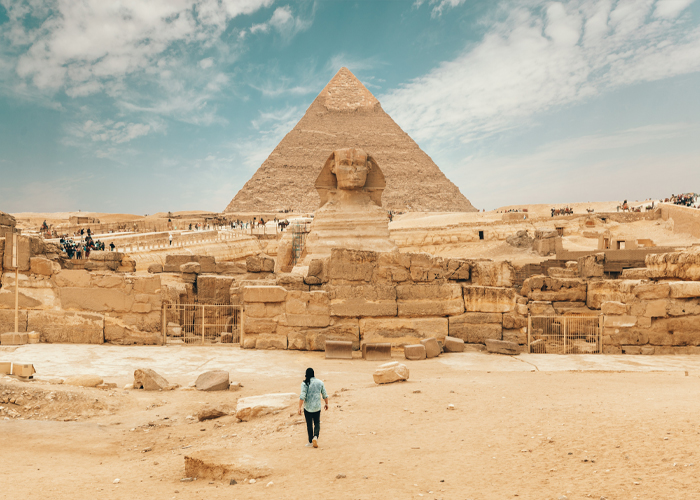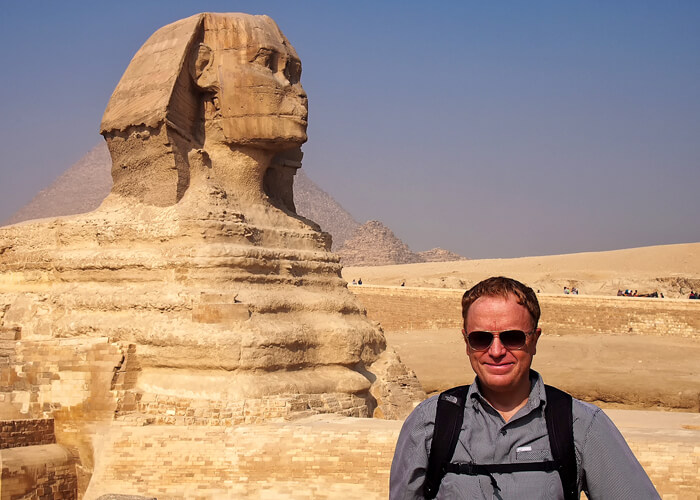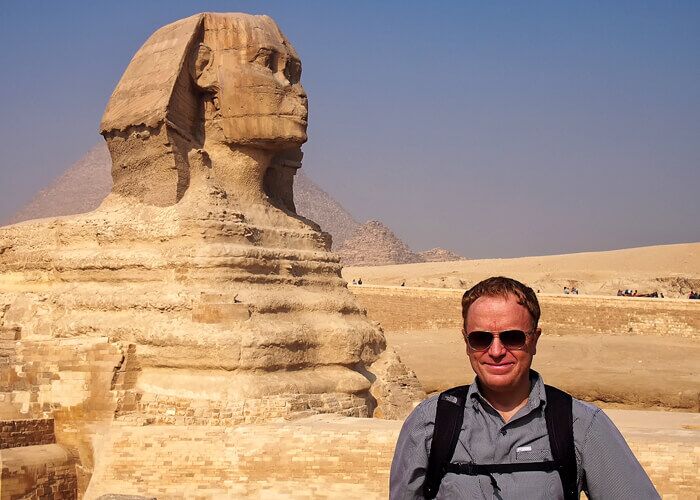Great Sphinx of Giza – Timeless Guardian of the Pyramids
Introduction
Great Sphinx of Giza stands as one of the most enigmatic and awe-inspiring monuments in the world. Towering silently near the Pyramid of Khafre, this colossal limestone statue has fascinated travelers, historians, and explorers for centuries. The sphinx of Giza is not merely a monument but a symbol of ancient Egyptian civilization, embodying mystery, artistry, and power. For anyone planning tours to Egypt, seeing the great sphinx giza in person is a highlight of their journey. Travelers often search for the great sphinx of giza photos before visiting, but no picture compares to standing at its base and witnessing the scale and detail with their own eyes.
Over the centuries, countless legends have surrounded the great sphinx of giza nose, which is famously missing, sparking debates about history, symbolism, and even foreign invasions. The Egyptian sphinx has been referenced as “Abulhoul Egypt” or “Abu al Houl,” meaning “Father of Terror,” a name that reflects both awe and reverence. Whether you are curious about the great sphinx meaning, fascinated by ancient architecture, or seeking facts about the great sphinx of giza for your travels, this monument never disappoints. With each visit, the great sphinx of giza Egypt reveals something new, drawing travelers deeper into its story and enriching their tours of Giza.
The History and Origins of the Great Sphinx
The great sphinx of giza is widely believed to have been built during the reign of Pharaoh Khafre, around 2500 BCE. Its construction required immense skill, as it was carved directly from a single limestone ridge on the Giza Plateau. Unlike the pyramids, which were assembled block by block, the sphinx was sculpted from existing rock, making it one of the largest monolithic statues in the world. Scholars often link the great sphinx meaning to protection, as it was positioned to guard the Pyramid of Khafre and serve as a spiritual sentinel of the necropolis.
Despite being one of the most studied monuments, the great sphinx facts still stir debate. Some theories suggest it could be older than traditionally believed, possibly predating Khafre’s era. These discussions add to the mystery and fascination that travelers feel when they encounter the sphinx pyramid facts during their tours. The missing sphinx of giza nose has also fueled speculation, with theories ranging from natural erosion to deliberate destruction by invaders. Yet despite centuries of wear, the great sphinx of giza height remains impressive, standing 20 meters tall and stretching 73 meters in length.
Explorers throughout history, from Napoleon’s soldiers to 19th-century adventurers, have left written records about their encounters with the Egyptian sphinx. Today, the great sphinx of giza tours allow modern travelers to follow in their footsteps, experiencing the monument not just as a relic of history but as a living piece of Egypt’s cultural heritage.

Symbolism and the Mystique of the Sphinx
What is the great sphinx of giza? Beyond being an extraordinary statue, it carries deep symbolic weight. The fusion of a lion’s body with a human head, often thought to represent King Khafre himself, embodies strength, wisdom, and authority. This unique form inspired later civilizations and continues to symbolize mystery in the modern imagination. The Egyptian sphinx facts suggest that the statue served both religious and political purposes, reinforcing the divine power of the pharaoh.
The great sphinx of giza meaning has fascinated scholars and travelers alike. Many associate the monument with the rising sun, aligning it with solar worship that was central to Egyptian religion. For travelers on sphinx of Egypt tours, guides often explain how the monument was once brightly painted, with traces of red pigment found on its face. Imagine the impact it would have had thousands of years ago, painted and gleaming in the desert sun.
The story of the great sphinx giza also includes ancient texts, such as the Dream Stele of Pharaoh Thutmose IV. This inscription, found between the paws of the sphinx, describes how Thutmose fell asleep near the statue and dreamed that the sphinx promised him kingship if he cleared away the sand that buried its body. This tale links the monument with divine favor, adding a legendary dimension to the great sphinx of giza facts still shared on tours today.
Physical Features and Architectural Marvels
When standing before the great sphinx of giza Egypt, travelers are struck by its sheer scale. The statue measures approximately 73 meters long and 20 meters high. Although time has eroded much of its detail, the khafre-era craftsmanship remains evident in its structure. The great sphinx of giza height makes it one of the most imposing monuments of antiquity.
A closer look inside reveals fascinating details. While the statue is solid, there are chambers and tunnels beneath it that have sparked centuries of curiosity. Some explorers speculated about hidden passageways leading to the pyramids, inspiring myths and adventure stories. Though many of these theories remain unproven, the fascination persists, adding to the appeal of great sphinx of giza tours.
One of the most discussed features is the sphinx of giza nose, which was broken off centuries ago. Travelers often ask about this mystery, and while the true cause remains debated, the missing feature has become a part of the great sphinx of giza facts shared worldwide. From a traveler’s perspective, the monument’s weathered condition does not diminish its impact—instead, it makes standing before it even more powerful, as it has endured thousands of years of history.
The Sphinx in Modern Travel and Tourism
For modern travelers, visiting the great sphinx of giza is an unforgettable highlight of Egypt tours. Standing before the Egyptian sphinx allows visitors to step into the same landscape that pharaohs, priests, and explorers once walked. Travel agencies offering sphinx of Egypt tours ensure that guests experience not just the monument but also the stories, legends, and great sphinx facts that make it unique.
Tourists often ask, “What is the great sphinx of giza?” Guides typically begin by explaining its purpose, symbolism, and fascinating history. Many visitors also seek out great sphinx of giza photos to capture their memories, though most agree that the emotional impact of seeing it in person cannot be fully conveyed through images. The monument’s presence against the backdrop of the pyramids creates a dramatic scene that remains one of the most photographed sites in Egypt.
The great sphinx of giza tours are often paired with visits to the nearby pyramids, offering travelers a full experience of Giza’s wonders. For those curious about Egyptian sphinx facts, local guides enrich the visit with stories ranging from ancient rituals to modern archaeological discoveries. The monument also carries cultural significance for Egyptians today, known locally as abu al hol or abulhoul Egypt, reflecting its continued importance in national identity and heritage.

Facts and Fascinations Surrounding the Sphinx
There are countless facts about the great sphinx of giza that intrigue both scholars and travelers. The great sphinx of giza height makes it the largest monolithic statue in the world. It is estimated that the statue was carved from over 200,000 tons of limestone, a testament to the skill and ambition of ancient builders.
Another of the great sphinx of giza facts is that the monument has undergone numerous restorations over the centuries. From ancient pharaohs to modern archaeologists, efforts to preserve the Egyptian sphinx reflect its enduring significance. Visitors often marvel at how the monument continues to stand strong despite centuries of erosion, invasions, and natural decay.
The great sphinx of giza nose remains one of the most discussed mysteries. Some legends claim it was destroyed by Napoleon’s soldiers, while others suggest it was damaged much earlier. Regardless of the truth, it has become an essential part of the great sphinx facts travelers learn on tours.
From sphinx pyramid facts to Egyptian sphinx facts, travelers leave with more than just photos—they take home stories that enrich their appreciation of Egypt’s history. Every detail, from the missing features to the surviving artistry, enhances the fascination of the great sphinx of giza Egypt and ensures its place as a must-visit destination.

